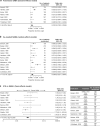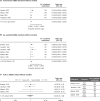Safety of SABA Monotherapy in Asthma Management: a Systematic Review and Meta-analysis
- PMID: 36348141
- PMCID: PMC9859883
- DOI: 10.1007/s12325-022-02356-2
Safety of SABA Monotherapy in Asthma Management: a Systematic Review and Meta-analysis
Abstract
Introduction: Short-acting β2-agonist (SABA) reliever overuse is common in asthma, despite availability of inhaled corticosteroid (ICS)-based maintenance therapies, and may be associated with increased risk of adverse events (AEs). This systematic literature review (SLR) and meta-analysis aimed to investigate the safety and tolerability of SABA reliever monotherapy for adults and adolescents with asthma, through analysis of randomized controlled trials (RCTs) and real-world evidence.
Methods: An SLR of English-language publications between January 1996 and December 2021 included RCTs and observational studies of patients aged ≥ 12 years treated with inhaled SABA reliever monotherapy (fixed dose or as needed) for ≥ 4 weeks. Studies of terbutaline and fenoterol were excluded. Meta-analysis feasibility was dependent on cross-trial data comparability. A random-effects model estimated rates of mortality, serious AEs (SAEs), and discontinuation due to AEs (DAEs) for as-needed and fixed-dose SABA treatment groups. ICS monotherapy and SABA therapy were compared using a fixed-effects model.
Results: Forty-two studies were identified by the SLR for assessment of feasibility. Final meta-analysis included 24 RCTs. Too few observational studies (n = 2) were available for inclusion in the meta-analysis. One death unrelated to treatment was reported in each of the ICS, ICS + LABA, and fixed-dose SABA groups. No other treatment-related deaths were reported. SAE and DAE rates were < 4%. DAEs were reported more frequently in the SABA treatment groups than with ICS, potentially owing to worsening asthma symptoms being classified as an AE. SAE risk was comparable between SABA and ICS treatments.
Conclusions: Meta-analysis of data from RCTs showed that deaths were rare with SABA reliever monotherapy, and rates of SAEs and DAEs were comparable between SABA reliever and ICS treatment groups. When used appropriately within prescribed limits as reliever therapy, SABA does not contribute to excess rates of mortality, SAEs, or DAEs.
Keywords: Adolescents; Adults; Adverse events; Monotherapy; Mortality; Overuse; SABA; Safety.
© 2022. The Author(s).
Figures




References
-
- National Heart LaBI. Guidelines for the diagnosis and management of asthma (EPR-3); 2007. https://www.nhlbi.nih.gov/sites/default/files/media/docs/EPR-3_Asthma_Fu.... Accessed May 2022.
-
- Global Initiative for Asthma (GINA). Global Strategy for asthma management and prevention; 2018. https://ginasthma.org/wp-content/uploads/2019/01/2018-GINA.pdf. Accessed June 2022.
Publication types
MeSH terms
Substances
Grants and funding
LinkOut - more resources
Full Text Sources
Medical

